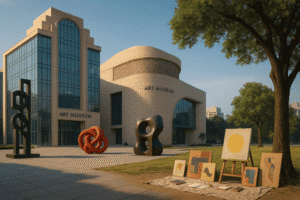Indian Art Philanthropy Crisis: 7 Shocking Truths Behind the Billion-Dollar Museum Boom
India’s cultural landscape is dominated by monumental new institutions funded by corporate wealth – Kiran Nadar’s KNMA, Nita Ambani’s NMACC, and Sunil Munjal’s upcoming Brij. Yet, a profound tension exists: this surge in physical infrastructure isn’t matched by equivalent support for emerging artists or experimental art. Critics like collector Abhishek Poddar bluntly state art philanthropy is “in very poor health,” arguing the booming market primarily benefits established, often deceased artists.
Many see these mega-projects as “asset building,” enhancing collectors’ holdings and status rather than nurturing a risky, vibrant ecosystem. This leaves young artists grappling with an “anxiety of insignificance.” While respected grassroots initiatives (Arthshila) and artist legacy foundations (Raza, Sher-Gil Sundaram) offer counterpoints, the central question remains unanswered: Will these glittering citadels become incubators for the truly new, or merely mausoleums for established value?

Indian Art Philanthropy Crisis: 7 Shocking Truths Behind the Billion-Dollar Museum Boom
The recent $13.8 million auction of M.F. Husain’s “Gram Yatra” wasn’t just a record-breaker; it became a Rorschach test for Indian art philanthropy. While Kiran Nadar’s acquisition (strongly rumored, though officially “unnamed”) promises the painting’s return to India, likely to grace her eponymous museum’s halls, the staggering sum underscores a profound tension within India’s cultural boom: a surge in monumental institutions seemingly unmatched by a parallel commitment to nurturing the new.
India’s corporate aristocracy is building cultural citadels. Nadar’s Kiran Nadar Museum of Art (KNMA), a behemoth designed by David Adjaye near Delhi’s airport, promises 100,000 sqm of space by 2026. Nita Ambani’s Nita Mukesh Ambani Cultural Centre (NMACC) in Mumbai, opened lavishly in 2023, blends contemporary Indian shows with Bhakti art and Yayoi Kusama’s infinity rooms alongside spectacular musical theatre. Sunil Munjal is pouring resources into “The Brij,” touted as a one-million-square-foot “live museum” in Delhi, while his Serendipity Arts Festival in Goa mixes visual arts and performance for massive audiences and now expands to Birmingham.
The Shock of the New? Or the Comfort of the Established?
Yet, speaking with artists, curators, and philanthropists reveals a pervasive unease beneath the glittering facades. Abhishek Poddar, founder of the tech-forward Museum of Art & Photography (MAP) in Bengaluru (home to that Husain hologram), states bluntly: “Art philanthropy is in very poor health.” His critique centers on the market’s dominance: “The art market is booming, but these are collectors, and most of them are buying artists who are dead.”
The concern echoed by many is that current mega-philanthropy often functions as “asset building,” enhancing the value of existing, largely blue-chip collections (like Nadar’s Husain purchase) and the cultural capital of their owners, rather than fostering risk-taking or supporting the emerging ecosystem. As one prominent installation artist lamented, young artists now grapple with “the anxiety of insignificance, of not making it to the monied institutions.”
Nostalgia for a Different Kind of Patronage:
Ironically, a sense of nostalgia pervades conversations, even amongst the new guard, for a pre-liberalization era. Poddar recalls the 70s and 80s fondly: “There was more real philanthropy and people who were genuinely interested in art.” He sees the contemporary art world increasingly “playing it safe and doing what sells.”
This nostalgia connects figures across generations. Shalini Passi, an art collector and reality TV star whose fame surged via “Fabulous Lives vs Bollywood Wives,” traces her passion to a schoolteacher introducing her to masters like B.C. Sanyal and Manjit Bawa. Sunil Munjal similarly credits his early start in collecting to an inspirational art teacher. Kiran Nadar’s record-breaking Husain purchase itself carries a whiff of affectionate settling of scores, recalling a time when the artist “didn’t take her seriously” as a young patron.
Grassroots Glimmers and the Path Ahead:
Amidst the critique of the ultra-wealthy, genuine admiration exists for less-heralded initiatives. The Arthshila Foundation takes exhibitions and residencies beyond metros. Artist legacy foundations like the Gujral, Raza, and Sher-Gil Sundaram foundations receive respect for their focused dedication. MAP, while founded by a collector, is noted for its public engagement and accessible tech-forward approach.
The True Test of Generosity:
The anticipated homecoming of Husain’s “Gram Yatra” to the KNMA is symbolically potent. It represents the financial muscle of India’s new cultural philanthropy. Yet, the true measure of this philanthropy’s legacy won’t be the price tag on a modernist masterpiece or the square footage of a new museum wing. It will be found in the answer to a pressing question: Are these palatial institutions merely mausoleums for established value, or will they become vibrant incubators that actively seek out, challenge, and sustain the shock of the truly new in Indian art?
The institutions have been built. The world is watching to see what – and more importantly, who – will fill them next. The patronage of living, evolving, and challenging contemporary art remains the sector’s most significant, and still unmet, opportunity.
You must be logged in to post a comment.